Red Sox: Where starting rotation ranks among AL playoff teams

Ranking the starting rotations of each of the teams to qualify for the postseason in the American League. How does the Boston Red Sox staff stack up?
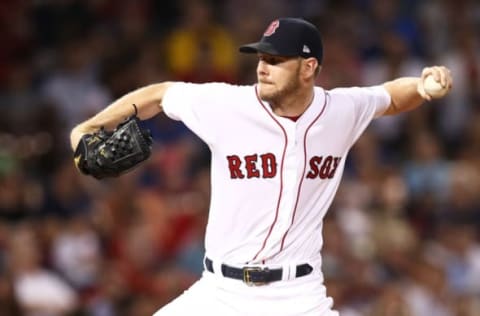
The old narrative is that pitching wins in the postseason. While there’s a bit more to it than that, especially in an era where home run rates are skyrocketing on an annual basis, pitching remains the key ingredient to success in the playoffs. The Boston Red Sox have quality pitchers on their roster but how do they stack up against the competition in the American League this postseason?
There are a number of factors that go into ranking the pitching staffs of the five teams to qualify for the playoffs. The rotation’s collective production can be measured using a mixture of common statistics (i.e. ERA, batting average against, strikeouts) and advanced (i.e. WAR, K/BB ratio, xFIP). However, these stats don’t tell the full story.
Rotations anchored by a dominant ace weigh more heavily in a postseason series where they may get the opportunity to pitch at least twice. Teams also only need four starters in the postseason, so we can ignore the results from a fifth starter, or spot starters, who may have been dragging down the team’s numbers.
Let’s take a look at the playoff rotations for each qualified team to see where Boston’s staff ranks.
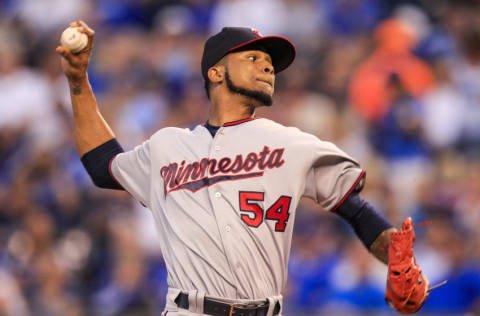
Minnesota Twins
Playoff Rotation: Ervin Santana, Jose Berrios, Kyle Gibson, Bartolo Colon
The Twins rank a distant last on this list with a rotation that was 10th in the league with a 4.73 ERA and 7.7 fWAR.
Minnesota used a staggering 16 different pitchers to start at least one game, so the bevy of spot starters clearly dragged down the staff’s overall production. However, if you count only the four pitchers who make up the Twins expected postseason rotation if they advance to the ALDS, their collective 4.17 ERA would still rate last among AL playoff teams.
Santana was easily their best pitcher, ranking fifth in the league with a 3.28 ERA. The career year for the right-hander was a bit of smoke and mirrors. His 4.77 xFIP indicates he wasn’t nearly as effective as his ERA suggests and his middling K/9 and K/BB ratio are below the standards of the typical ace.
If the Twins manage to win the Wild Card game, Santana would likely only be available for one start in the ALDS against the Cleveland Indians. That’s bad news for Minnesota, as none of their other pitchers can stack up against what the Tribe will throw at them.
Berrios had a solid first full season in the big leagues but was a disaster on the road (5.17 ERA) where he’ll likely take the mound in a potential series with Cleveland. He found success in his lone trip to Progressive Field this season, holding the Indians to one run over 7 1/3 innings. Minnesota would need a repeat performance to have a chance considering he’ll be matched up against Corey Kluber.
Gibson’s season numbers are horrific but he vastly improved over the second half, posting a 3.76 ERA over his final 13 starts.
Colon is no lock to take the final rotation spot. At times he looked to be perhaps the worst pitcher in baseball yet he managed to stick in Minnesota’s rotation. The same can’t be said for Adalberto Mejia, who pitched mostly in long relief down the stretch. The experience factor probably gives Big Sexy the nod but it probably won’t be pretty – if the Twins even make it that far.
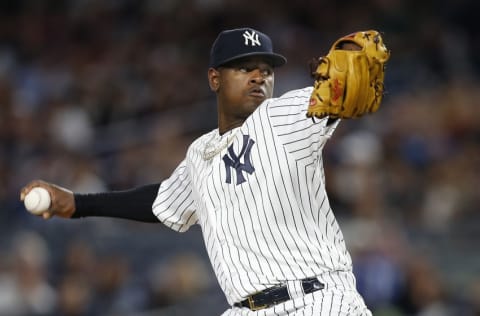
New York Yankees
Playoff Rotation: Luis Severino, Sonny Gray, Masahiro Tanaka, C.C. Sabathia
New York’s rotation ranked second in the league with a 3.98 ERA, 2.42 batting average against and tied for third with a 15.2 fWAR.
Severino has developed into a true ace, ranking third in the league with a 2.98 ERA and 1.04 WHIP, fourth with a 10.71 K/9 and fifth with a 4.51 K/BB ratio. He gives the Yankees a huge advantage in the Wild Card game against the Twins. However, taking the mound on Tuesday means that even if the Yankees advance, Severino will likely to limited to one start in the ALDS. This limits his value as an ace in a short series compared to the top starters on the division-winning teams.
More from Red Sox News
- Red Sox Nation deserves far more from Fenway Sports Group
- Bizarre trade deadline comes back to haunt Red Sox after Nathan Eovaldi departure
- Red Sox’ Moneyball-style offseason continues with Corey Kluber contract
- Rich Hill’s Red Sox departure puts him within striking distance of unique MLB record
- Red Sox offseason takes another nasty hit with Nathan Eovaldi departure
The mid-season addition of Gray gave the Yankees a solid No. 2 starter, even if he predictably declined a bit with the move from Oakland to the Bronx. Gray also stumbled down the stretch, going 2-4 in September and getting torched in two of his final three starts.
Which version of Tanaka will the Yankees get in the postseason? He allowed three runs or less in 19 of his 30 starts this season but was lit up for 7+ runs five times – including twice in September. Tanaka’s 3.44 xFIP is significantly better than his 4.74 ERA and he’s still striking out over a batter per inning. He also tied for the third most home runs allowed with 35 and is prone to meltdowns.
Sabathia is no longer a guy who can blow hitters away with his fastball. He’s had to learn how to pitch and after a prolonged adjustment period, it seems he’s accomplished that. His strikeout rate has dipped to his lowest point since 2003 and he’s allowing more walks and home runs than he did at his peak but somehow the 37-year old is still getting it done. He’s not the imposing ace he once was but he’s an effective back of the rotation starter.
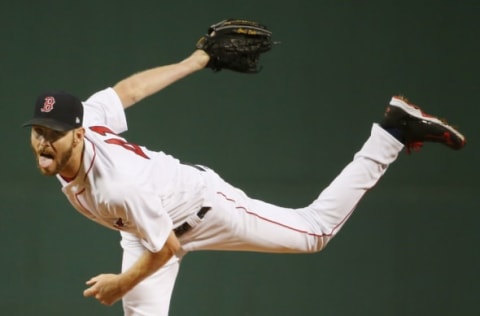
Boston Red Sox
Playoff Rotation: Chris Sale, Drew Pomeranz, Eduardo Rodriguez, Doug Fister
Red Sox starters were only fourth in the league with a 4.06 ERA but they were also second with a 9.47 K/9, 2.71 K/BB, 17.0 fWAR and 3.94 SIERA.
Boston was expected to have a three-headed monster leading the rotation, only it didn’t quite pan out that way. Sale was as excellent as advertised, finishing second in the league with a 2.90 ERA and 0.97 WHIP. He struck out a major league-leading 308 batters, making a run at the single-season franchise record.
Unfortunately, the other two heads of that monster whimpered instead of roared. Porcello took a big step back from his Cy Young campaign a year ago, leading the league in home runs allowed and losses. He’s become such a liability that the Red Sox may not even give him a postseason start. David Price battled elbow soreness throughout the season and has been relegated to the bullpen.
While two of their starters faltered, Pomeranz became a pleasant surprise. He won 17 games and his 3.32 ERA ranked seventh in the league. His career-high innings total is a bit of a concern and may explain his dip in velocity late in the season but he finished strong with six innings of one-run ball against an Astros team he’ll face again in the ALDS.
It’s not a three-headed monster but the Red Sox still have one of the best one-two punches in the AL with Sale and Pomeranz. After that, Boston faces a lot of question marks.
Rodriguez has shown flashes of brilliance but remains as inconsistent as he is inexperienced on this stage. Boston has yet to confirm their rotation but E-Rod figures to be included due to a lack of options.
At least Price’s conversion to lights-out reliever spares us the narrative of his postseason record, yet we can’t overlook that the only Red Sox starting pitcher candidate with a playoff win on their resume is Fister. The veteran who they scooped off the scrap heap and posted a career-worst 4.88 ERA is the only Red Sox starter to taste postseason glory.
Having only two reliable starters may not hurt as much in a five-game series but if Boston advances beyond the first round then their lack of rotation depth could come back to bite them.
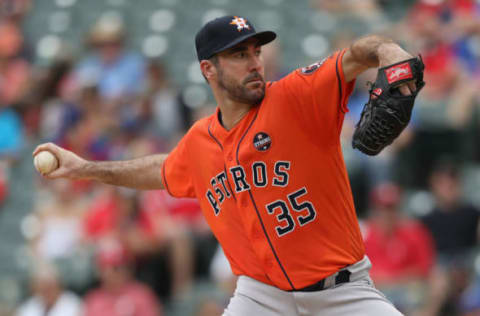
Houston Astros
Playoff Rotation: Dallas Keuchel, Justin Verlander, Brad Peacock, Charlie Morton
Astros starters were third in the league with a 4.03 ERA, .243 batting average against, 9.31 K/9 and 15.2 fWAR. Their 3.81 xFIP was second.
Houston’s production undersells the current state of their rotation, which received a drastic boost with the August waiver trade for Justin Verlander. The former Detroit Tigers ace was 5-0 with a 1.06 ERA and 11.38 K/9 in five starts since the Astros acquired him.
More from Red Sox News
- Red Sox Nation deserves far more from Fenway Sports Group
- Bizarre trade deadline comes back to haunt Red Sox after Nathan Eovaldi departure
- Red Sox’ Moneyball-style offseason continues with Corey Kluber contract
- Rich Hill’s Red Sox departure puts him within striking distance of unique MLB record
- Red Sox offseason takes another nasty hit with Nathan Eovaldi departure
Verlander gives the Astros a dominant co-ace to pair with Keuchel. The 2015 Cy Young winner bounced back from a down 2016 campaign to post a 2.90 ERA. Keuchel isn’t a dominant strikeout pitcher and his 2.66 K/BB ratio is middle of the pack but he’s still very effective.
Houston has the opposite problem that Boston has – they have too much pitching depth. Granted, that’s a good problem to have but they still need to decide between Peacock, Morton, Lance McCullers and Collin McHugh to fill two rotation spots.
McHugh was limited by injury to only 12 starts so he’s a more likely candidate to end up in the bullpen. McCullers was knocked around for five runs in his last start in Boston, giving the edge to Peacock and Morton.
Peacock (3.00 ERA) and Morton (3.62 ERA) both had solid seasons. They throw hard, each producing a strikeout rate of over 10 K/9. The one concern with each of them is the walks, as each produced a walk rate north of 3.0 BB/9. Peacock’s 3.90 BB/9 is particularly concerning and as impressive as the rest of his numbers are they are also slightly obscured by 13 relief appearances. He could be on a short leash, but at least Houston should have at least one starting caliber pitcher on standby in the event of a quick hook.
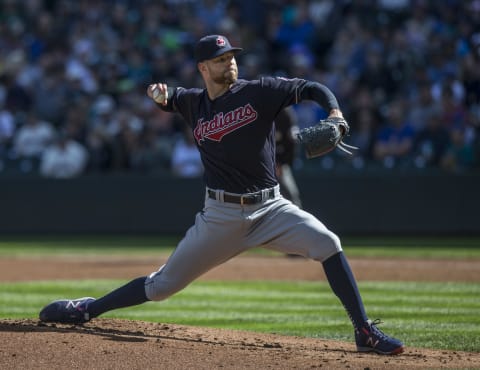
Cleveland Indians
Playoff Rotation: Corey Kluber, Carlos Carrasco, Trevor Bauer, Mike Clevinger
Cleveland’s rotation is first in the league with a 3.52 ERA, .241 batting average against, 10.08 K/9 and 23.1 fWAR.
Kluber’s dominant second half may have pushed him ahead of Sale in the Cy Young race. While he tossed fewer innings and finished a distant second in strikeouts to the Red Sox ace, Kluber still overtook the league lead with a 2.25 ERA and 0.87 WHIP.
Carrasco shared a piece of the league lead with Kluber in wins with 18, while ranking sixth with a 3.29 ERA and fifth with 226 strikeouts. His 4.91 K/BB ratio ranked behind only Kluber and Sale, who were in their own stratosphere.
Boston and Houston both have a pair of aces leading their rotation but it’s hard to put either team’s duo ahead of the combination of Kluber and Carrasco.
Bauer’s overall numbers aren’t all that impressive but he was a completely different pitcher in the second half, posting a 10-2 record and 3.01 ERA over his final 15 appearances. His 10.0 K/9 rate places him right behind Carrasco for sixth in the league. If he continues pitching at this level into the postseason, Bauer essentially gives Cleveland a third ace.
Clevinger’s 3.11 ERA may fool us into thinking Cleveland has a fourth ace but his 4.05 xFIP suggests otherwise. His 4.4 BB/9 rate is the main reason to doubt his shiny ERA. His 10.1 K/9 would actually put him just ahead of Bauer if he had enough innings to qualify, so if he’s the worst pitcher in Cleveland’s rotation then they are in pretty good shape.
Next: What if Red Sox never signed Moreland?
Cleveland has the best combination of stud pitchers to lead their rotation and solid options to back them up. They can use arguably the best pitcher in baseball at least twice in a series and still feel confident trotting any of their other starters out to the mound in games when Kluber isn’t available.